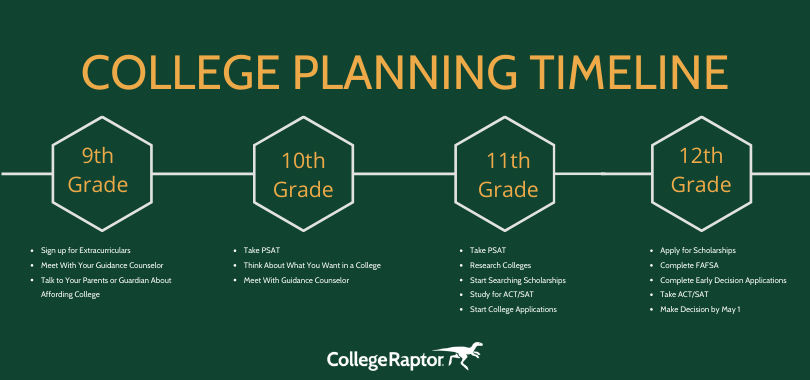Key Takeaways:
- January 1 is a common regular decision deadline for college applications, but students who want to apply early often need to submit applications in November.
- During high school, students should complete a variety of tasks to prepare for college, including meetings with academic advisors and scholarship research.
- Colleges start sending out regular decision letters in March, and students need to choose their school by May 1.
It’s never too early to plan for college. In fact, some students want to start preparing during middle school. By keeping on top of the must-do tasks, you’ll reduce the number of things you need to do at the last minute and avoid some serious stress. In this article, we’ve highlighted some important dates and provided you with a college planning timeline, all the way up to your move-in date.
Important Dates: Your College Planning Timeline
Although we provided more extensive checklists below, here are some important deadlines and dates you need to be aware of during your senior year of high school:
- October 1: The Free Application for Federal Student Aid (FAFSA) typically opens on October 1. During your senior year of high school, complete it as soon as possible with your parents. Most colleges require your submission by February to be considered for merit- and need-based scholarships.
- November 1 and 15: Early action and early decision I deadlines usually fall on November 1 or 15, though it depends on the college. Students often start hearing back in mid-December.
- December: If you’re applying through regular decision, the final accepted SAT/ACT test dates fall in December. (You’d need to complete it in October if you applied through early action or early decision).
- January 1: Most colleges have a regular decision deadline of January 1 or shortly after. Schools start sending out decision letters and financial aid offers in March.
- May 1: You’ll likely have to make your choice by May 1, College Decision Day. Submit any required paperwork with your deposit, and let other schools know you’re not attending.
- Mid- to late August: If you’re staying in a dorm on campus, you need to move in before your classes start. Colleges usually have first year students move in a few days before other students.
Middle School College Planning
Students can actually start planning for college in middle school. In fact, scholarship dollars could be on the line – Indiana’s 21st Century Scholars program is just one example. It requires students to apply during 7th or 8th grade.
Your grades during middle school can also impact your course choices in high school. If you do particularly well, you may get into advanced classes. Colleges like to see students with academic rigor on their high school transcripts.
High School College Planning Checklist
Once you get into high school, college planning ramps up.
9th Grade
There’s not much to do during your first year of high school, but try to tackle these:
- Sign up for extracurriculars. This is the perfect time to start looking into clubs, sports, volunteer opportunities, and extracurriculars that interest you. If you’re not sure what options are available to you, talk to your teachers. Colleges are looking for students who do more than just earn good grades. By signing up in 9th grade and continuing the extracurricular throughout high school, you show commitment and passion.
- Meet with your guidance counselor. Discuss your overall plans for high school, your schedule for 10th grade, and any ideas you have about college already with your guidance counselor or academic advisor. They may have suggestions for electives based on your interests and goals.
- Talk to your parents about affording college. College is expensive. Have a plan for affording the cost. Your parents or guardian might have created a 529 plan for you, but you may need to take out loans to cover the difference.
Print Your Freshman Year Checklist.
10th Grade
In 10th grade, you’re still in the planning stages, so keep these to-do’s in mind:
- Take the PSAT in October. If your school offers it, sit for the PSAT. Although you can consider it a practice exam – your results won’t have any impact on college or scholarships – you still should study. Knowing what to expect now can pay off big time in the years to come.
- Think about what you want in a college. As you enter the second half of 10th grade, keep a running list of what you want out of your education after high school. Consider where you’d like to attend (far away vs close), the setting (city vs village), and potential majors.
- Meet with your guidance counselor. As 10th grade ends, you’ll have to meet with your guidance counselor to go over your 11th grade schedule. Ask about AP and college courses and bring up any ideas you have about college.
Print Your Full Sophomore Year College Prep Checklist.
11th Grade
College planning ramps up big time in your junior year.
- Take the PSAT again. The PSAT during your junior year does matter. If you score well enough, you could be named a National Merit Scholar and win a scholarship. Studying now will also help you when it’s time to take the SAT or ACT.
- Research colleges in the fall. With your wants, needs, and interests in mind, create a list of potential colleges. Use College Match tools to uncover some of the best schools that fit you and your accomplishments and attend some college fairs. Your initial list may be long – you’ll narrow it down in the future.
- Search for scholarships. There are thousands of scholarships available to students – you just need to find the ones you qualify for and apply. Starting early means you’re more aware of deadlines and you’ll have time to apply to more. Use a scholarship database to discover awards, track your applications, and receive notifications.
- Study for (and take) the SAT/ACT. Many schools still require the SAT/ACT. From flashcards to practice tests to phone apps, there are plenty of options to help you tackle the exams. You should also think about which you’re going to take. Tip: play to your strengths. Schedule your first SAT/ACT for the spring of your junior year.
- Meet with your guidance counselor. And, of course, it’s time for the annual meeting with your academic advisor. Have conversations about AP and college courses, PSAT results, plans for senior year, thoughts about college, and any questions you have about your education now and in the future.
Print Your Full Junior Year College Prep Checklist.
Summer Between 11th and 12th Grades
While you should still take time to relax over the warmer months, the summer allows you plenty of opportunities to tackle some college planning must-dos.
- Narrow down your college list. Start crossing off schools that don’t fit you, whether it’s their admission requirements or your personal preferences. Identify whether the college is a reach, safety, or match. Apply to two to fifteen colleges.
- Visit college campuses. It’s best to visit colleges before you apply. Prior to each tour, research the school and create a list of questions. Explore a little on your own (in permitted areas) and talk to students on campus. If you’re concerned about cost, visit colleges that are high on your list first or plan trips only after you’ve been accepted and take virtual tours for now.
- Start college applications. You don’t have to submit your college applications just yet, but at least get started. Note deadlines, required materials, essay topics, and more. Weigh early action vs early decision vs regular decision, as it’ll affect your due dates. If you run into any questions, reach out to the admissions department sooner rather than later.
- Retake the ACT/SAT. Study with a goal in mind and take your second standardized test during the summer. You’re welcome to take them as many times as you’d like, time permitting.
12th Grade – Fall
It’s down to the wire. Use a planner or College Comparison Worksheet to track important deadlines and to-do lists. Keep in mind: each college is different. They’ll have varying deadlines and application requirements.
- Meet with your guidance counselor regularly. Discuss your college goals, application timelines, and more to get advice on your trajectory after graduation.
- Apply to scholarships. Set aside a few hours each week to research and apply to scholarships. While many awards are for graduating high school seniors, did you know there are also scholarships for college students?
- Complete the FAFSA. The FAFSA typically opens on October 1, but the date may vary from year to year. While you don’t have to complete it that very first day, schedule a time with your parents to submit yours as soon as possible. If you wait too long, you risk missing your schools’ deadlines.
- Take the ACT/SAT. Time permitting, take the ACT or SAT a third time. If you’re applying under early decision or early action, the latest ACT/SAT test date is generally October. For regular decision, have your tests done by mid-December.
- Ask for letters of recommendation. Most college applications require letters of recommendation. We highly recommend asking for them as soon as possible. Teachers are often busy, and others are asking them for letters, too.
- Complete early applications. Early action and early decision applications are usually due on November 1st or 15th. You might hear back by mid-December or even earlier. If you’re accepted under early decision, you’ll need to submit your deposit by the listed due date.
- Submit regular decision applications. Regular decision (and early action/early decision II) applications are usually due on January 1. Submit yours a week or two ahead of time to avoid any potentially technical issues.
12th Grade – Spring
The countdown to graduation starts.
- Wait for acceptance letters. Regular decision letters should come in March or early April. If you applied under early action/decision II, expect to see responses by mid-February. We recommend waiting for all of your letters to arrive before making a decision (unless you were accepted through early decision).
- Review financial aid packages. If you completed your FAFSA, you should receive financial aid offers with your letters or shortly after. They don’t follow a single format, so comparing them carefully can help you make a sound financial decision. Reach out to the financial aid office with any questions or concerns.
- Complete graduation tasks. Your high school will likely require you to complete a few tasks, such as buying your cap and gown. You might also want to attend prom and buy the yearbook.
- Don’t catch senioritis. Even if you have some acceptance letters, don’t slack off during the final months of high school. Colleges can (and have) rescind offers if your grades drop far enough.
- Visit colleges. Plan a first or second visit to any schools you’ve been accepted to and are highly considering. Many colleges offer tours designed for accepted students.
- Make your decision by May 1. Most college students have to submit their final decisions by May 1, College Decision Day. Let schools know if you’re not attending, too, and thank them for their consideration.
- Celebrate! You’ve done it—you completed four years, graduated high school, and are going to college in the fall. Now is the time to celebrate your accomplishments and treat yourself.
Print Your Senior Year College Planning and Prep Checklist.
After Graduation College Checklist
After high school graduation, you have a few months before you head off to college. Take some time for you and celebrate your achievements, but also focus on these tasks:
- Learn life skills. At college, you’re going to have to do your own laundry and you may have to cook occasionally. If there are any gaps in your life skill knowledge, get with your parents to learn them before you head off.
- Gain financial literacy. You’ve learned math, but what about financial literacy? Since you’re paying tens of thousands of dollars for your education, it’s more important than ever before. Some things you may need to do include opening your first checking or savings account, learning how to budget, and tracking spending. Discuss your finances with your parents to get started.
- Complete college to-do lists. Colleges will send you plenty of emails over the next few weeks, detailing tasks you have to complete before you can attend. Don’t ignore these. Get all of your documents and forms completed as soon as possible to avoid any last-minute issues.
- Attend orientation. Many schools require you to attend orientation, where you meet other students, register for classes, and explore your new campus.
- Plan for move-in day. Most college students move in during late August, starting classes soon after. Create a packing list, buy your books, and start getting excited!
It’s definitely a lot to do, but if you start early, you won’t be rushing around at the last minute. You could even increase your admission chances by researching colleges sooner rather than later.
No matter where you are in your college planning experience, College Raptor has the tools you need to make the process less stressful and less challenging. Take advantage of:
- College Match tool to uncover the best schools for your wants and needs.
- Financial Aid Offer Comparison tool to cut through the complexity of your offers.
- And discover awards you qualify for with our Scholarship Search.







